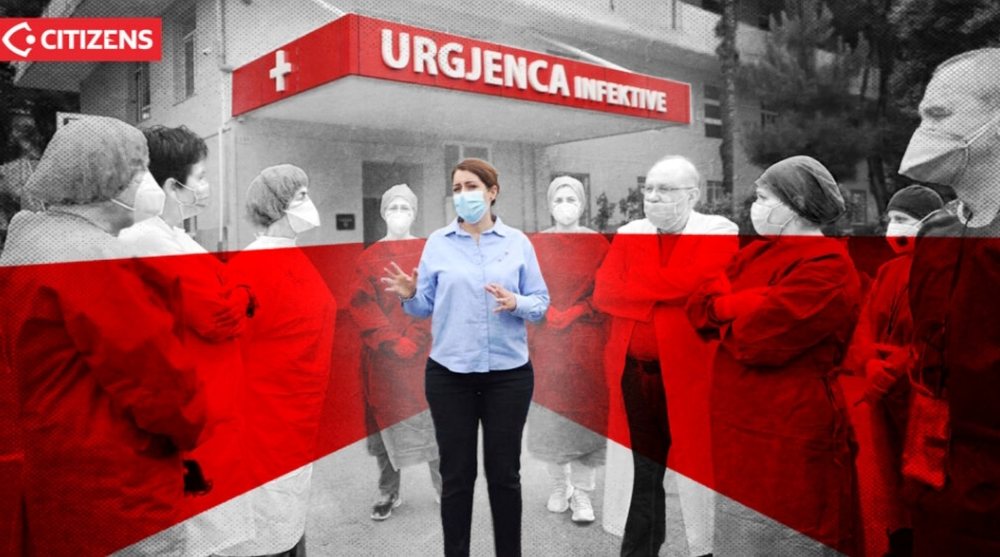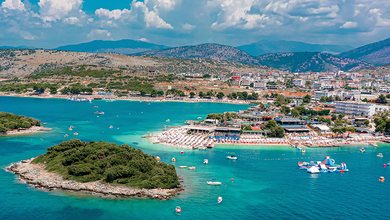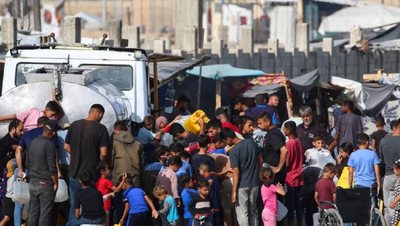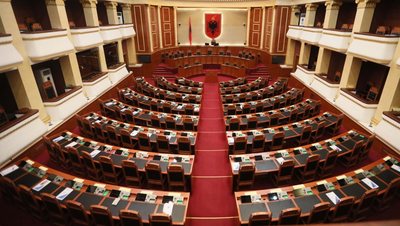
There are many stories worth telling about the COVID-19 pandemic. But, if we analyze them, almost all of them talk about politics and decision-making.
Which authority managed it: the government or the scientific community of doctors? Above all, was there transparency and room for criticism?
According to the government, it acted in time, the figures show 310 thousand infected and 3,625 deaths.
The government says it has managed the situation successfully. According to it, only 11.5% of the population was infected with the virus and 1.2% of those infected lost their lives.
But what happened beyond these figures and what is being said about the pandemic today?
"Crime and Punishment" among the white shirts
The COVID-19 alarm in Albania was raised by news from Italy. It was February 2020. Hundreds of victims were reported every day in the neighboring country, fueling fear and uncertainty.
Albanians were distracted from the threat of the virus by the trauma left behind by the November 2019 earthquake. The virus had actually been rumored around the world for at least four months.
Ilir Allkja was a Mobile Emergency Physician at the "Mother Teresa" University Hospital Center (QSUNT). He recalls for Citizens.al that initially, caution was taken for cases with a travel history from Italy.
The symptoms were similar to the flu or a cold: fever, chills, and a severe cough. But ambulance calls began to hide suspected COVID-19 cases with abdominal pain or vomiting.
When COVID-19 was suspected, the emergency team wore protective clothing. They were not used for regular calls.
For weeks, Dr. Allkja's team faced dangerous cases of infection.
On March 9, 2020, the government officially confirmed the first case of COVID-19 in Albania.
Allkja remembers at least three suspicious cases from the evening after. The Emergency Center referred them as rheumatological, neurological, and gastrointestinal problems. But all three patients had come from Italy and had fevers.
"They had fevers, while they had been referred for concerns that had nothing to do with COVID-19," says Allkja, explaining that he and the team had set off without protective clothing.
The next day, March 11, the World Health Organization declared the infection a global pandemic.
Shocked by the developments and the recurring situation, Allkja says he contacted the Head of Service at QSUNT and the director of the National Center for Medical Emergencies.
“I didn't receive any response, not even a word of support,” Allkja recalls to Citizens.al. He still keeps the message he sent on his phone.
Overwhelmed by fatigue, fear of infection, and institutional neglect, the mobile emergency doctor was locked in quarantine. For him and his colleagues, there was no psychological help, despite the stress and extraordinary dynamics in the rhythms of work.
In these conditions, Allkja published a video on Facebook. He appealed for more care and coordination for protective measures. His goal was to raise awareness about preserving the lives of the white shirts.
"Clothes are worth less than our lives," was his public appeal.
But, in 9 months (until December 2020), over 50 doctors lost their lives to COVID-19. Among them were two colleagues from Allkja.
In April, as the government was considering easing restrictive measures, Allkja made another appeal.
He suggested decentralizing treatments beyond QSUNT and the "Shefqet Ndroqi" hospital to include regional hospitals.
Well-informed by developments in other countries, such as France, Allkja addressed an open letter to the government. He advised the involvement of the referral system – family doctors.
This approach was used by the government only at the end of 2020. At that time, the official toll of the pandemic had reached 23,500 cases with about 1,200 deaths.
On December 30, 2020, Allkja was on duty when he received his termination letter. At the height of the pandemic, he was fired without notice.
"I was expecting it after I was publicly lynched, not for any offense, but because I asked for more lives to be saved," the doctor says.
The government labeled Allkja an “opposition militant.” The Directorate justified the dismissal with ethical violations in the public positions he had held.
Today, Allkja works in a private hospital. According to him, political propaganda limited and instrumentalized healthcare professionals.
"They had the audacity to even hold concerts in hospitals," Allkja adds, describing it as an extremely frustrating period.
Inaction and avoidance of information
During the pandemic, I was a journalist at Euronews Albania. In October 2020, the Deputy Minister of Health, Mira Rakacolli, was invited to Ilva Tare's show.
The media had been questioning the official toll of the pandemic for seven months. The government was only reporting hospital deaths as confirmed COVID-19 cases.
I suggested to the information manager that she ask the deputy minister about this very issue. Did the government also have data on non-hospital deaths and could it make them public?
"If you had given me the questions before, I would have come [with the data]..." said Rakacolli.
"Without a doubt, yes!" he added in response to whether the figures could be provided following a request for information.
The request was sent, but the response never came. Five years later, the balance of the COVID-19 pandemic has not been reviewed, or at least not published.
On the contrary. The official website that once kept the pandemic figures has been emptied of information. The Institute of Public Health (IPH) addresses you to the Ministry of Health.
Instead of a complete picture, only partial answers are officially given. The ministry told Citizens.al that the national emergency “ended on May 5, 2023.”
This was not supported by any government decision or order, but by a link to the WHO homepage. In this way, it appears that Albania does not have an official date for when it emerged from the coronavirus pandemic.
As a final balance, the ministry gave the daily report dated April 25, 2023 with 310,536 infected and 3,625 dead.
After the intervention of the Commissioner for the Right to Information, the IHP said that “only the emergency has been lifted” and that “the pandemic continues.” According to the IHP, final analyses will be conducted “at the end of the pandemic.”
Meanwhile, the ministry acknowledged 32 deaths among the white shirts, including four nurses. But this does not match the data from the Albanian Medical Order. For Citizens.al, he spoke about 59 doctors who died during the pandemic.
The "hidden" death toll
Before the pandemic, 21,000-21,500 people lost their lives in Albania each year. A multi-year average, with an increasing trend that was mainly related to the aging of the population.
But during the pandemic, the recorded deaths significantly exceeded this ratio. The trend surpassed the average and produced a war balance that has not yet been justified by the Albanian authorities.
According to INSTAT, in 2020, 27,605 deaths were recorded in Albania. The first year of the pandemic recorded 25.8% more fatalities than 2019.
In 2021 there were 30,507 deaths – 10.5% more than in 2020. A year later, 23,998 deaths – 21.3% less. While in 2023 the figures returned to the multi-year average (21,286 deaths, 11.3% less than in 2022).
In total, during the three and a half years of the pandemic, Albania suffered 17,500 more deaths than normal. This raises the suspicion that the fatalities are directly or indirectly related to the consequences of COVID-19.
However, the government recognizes only 3,625 deaths from coronavirus, about 5 times less than this wave of deaths. The figure is only for the period March 2020-April 2023, which was confirmed by both the ministry and the IHP.
It is likely that limited testing meant that not all deaths were included in the official tally. Death was counted as caused by COVID-19 only if: the victim tested positive and was reflected in the death certificate.
Throughout the pandemic, the government was criticized for a lack of transparency and low testing.
As of April 16, 2023, 2,052,830 tests had been conducted. The overall average was 1,808 tests per day – with a coverage of 664 tests per 1,000 population.
For comparison, in June 2022, countries like Serbia or North Macedonia had a coverage of 986 to 1,434 tests per 1,000 inhabitants each day.
With less testing, Albania had fewer confirmed cases. Consequently, fewer reported deaths from COVID-19.
Other data from INSTAT support this idea. For example, deaths from respiratory diseases increased significantly during the pandemic.
Usually, before, they ranged in the range of 500-700 deaths per year. During the three years of the pandemic, a total of 6,878 deaths from these diseases were reported – 3,233 in 2022 alone.
This suggests that many of these deaths may have been related to COVID-19 – an infection that affects the respiratory tract. They may not have been classified as coronavirus deaths due to a lack of testing.
These data show the need for in-depth analysis. The official balance of the pandemic in Albania must be reviewed. Thousands of deaths cannot be hidden for propaganda purposes.
The need for reform and reflection
Five years after the outbreak of the pandemic, criticism of its management remains.
Taulant Muka, an epidemiologist, was working at a university in Switzerland during the pandemic. As a researcher, he brings a dual perspective: from within academia and outside the Albanian healthcare system.
According to him, the government applied a completely political rather than scientific approach to managing the situation. Muka believes that it even made the situation worse.
“The government commission left out scientific experts, who could have provided more effective guidance,” he says.
According to Muka, the measures were uncoordinated and often tragicomic, largely borrowed from other countries.
"Tanks were brought out in Tirana to fight the virus," he recalls, along with absurd instructions for "diagonal" taxi rides.
According to Muka, these decisions showed a total lack of scientific leadership.
At the start of the pandemic, he had conducted independent projections of the toll Albania was at risk of. One of his scenarios predicted 16-18 thousand additional deaths.
“Unfortunately, these predictions were confirmed,” he tells Citizens.al. The data reviewed above from INSTAT reports seem to support this thesis.
"Government measures had no measurable impact on reducing mortality," Muka emphasizes.
He also criticizes the concentration of treatment only in the Infectious Diseases Hospital. According to him, this strategy was used more for information control than health care.
Muka says that Albania also suffered from a lack of scientific capacity. Universities did not produce data or analysis that could help the government manage the crisis. While academics were involved in political propaganda.
This claim appears to have been confirmed by the University of Medicine. The Faculty of Medical Technical Sciences told Citizens.al that by April 2025, it had only produced four scientific papers.
One of the papers addressed the potential impacts of the virus on patients with diabetes. The others, published in 2020-2022, focused on the consequences on the mental health of medical staff.
Meanwhile, the lack of clear medical controls and protocols brought consequences.
Muka mentions the uncontrolled mass use of antibiotics and the transformation of clinics and pharmacies into unregulated markets. This, he said, has created a dangerous scenario for citizens' pockets and health.
Looking ahead, Muka shares the belief that in-depth scientific and institutional research is needed to manage the pandemic. He says it is important to examine the evidence on which the measures taken were based.
“The Ministry of Health should be held responsible for the additional deaths,” Muka said. According to him, Albania was ranked among the countries with the highest mortality rate in Europe during the pandemic.
"Without sincere reflection and deep reforms, especially in higher education, we will remain unprepared for the challenges ahead," he concludes.
Source: Citizens Channel






















